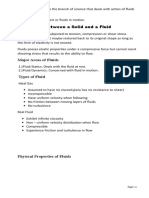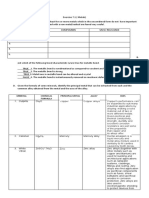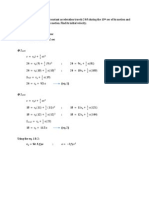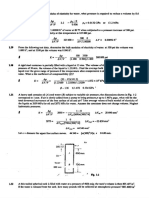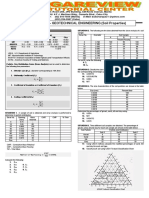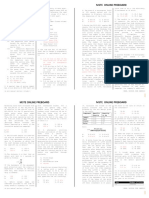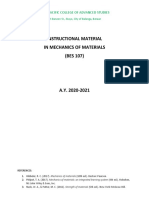Chapter II Strain 2.7
Chapter II Strain 2.7
Uploaded by
Joshua John JulioCopyright:
Available Formats
Chapter II Strain 2.7
Chapter II Strain 2.7
Uploaded by
Joshua John JulioOriginal Title
Copyright
Available Formats
Share this document
Did you find this document useful?
Is this content inappropriate?
Copyright:
Available Formats
Chapter II Strain 2.7
Chapter II Strain 2.7
Uploaded by
Joshua John JulioCopyright:
Available Formats
Chapter I
STRESS The circumferential stress can be
obtained from the free-body diagram in Fig.
2.7 Thin-Walled Pressure Vessels 2.12(b). This free body is obtained by taking the
slice of infinitesimal length 𝑑𝑥 shown in Fig.
A pressure vessel is a pressurized 2.12(a) and cutting it in half along a diametral
container, often cylindrical or spherical. The plane.
pressure acting on the inner surface is resisted by The fluid isolated by the cuts is
tensile stresses in the walls of the vessel. If the considered to be part of the free-body diagram.
wall thickness t is sufficiently small compared to The resultant force due to the pressure acting on
the radius r of the vessel, these stresses are the diametral plane is 𝑝(2𝑟𝑑𝑥), where 2𝑟𝑑𝑥 is the
almost uniform throughout the wall thickness. It area of the plane.
can be shown that if 𝑟/𝑡 ≥ 10, the stresses If we assume the circumferential stress 𝜎𝑐
between the inner and outer surfaces of the wall in the wall of the cylinder is constant throughout
vary by less than 5%. In this section we consider the thickness, then its resultant force is 2(𝜎𝑐 𝑡𝑑𝑥).
only vessels for which this inequality applies. Neglecting the weight of the fluid and the
vessel, we find that the equilibrium of vertical
a. Cylindrical Vessels forces becomes
Consider the cylindrical tank of inner
radius r and wall thickness t shown in Fig. 1.9(a). Σ𝐹𝑣 = 0 ↑ +
The tank contains a fluid (or gas) under pressure 2(𝜎𝑐 𝑡𝑑𝑥) − 𝑝(2𝑟𝑑𝑥) = 0
𝑝. In this simplified analysis, we assume that the
weights of the fluid and the vessel can be which yields for the circumferential stress
neglected compared to the other forces that
act on the vessel. The tensile stresses in the wall 𝑝𝑟 𝑝𝐷
𝜎𝑐 = = Equation (2-17)
that resist the internal pressure are the 𝑡 2𝑡
longitudinal stress 𝜎𝑙 and the circumferential
stress 𝜎𝑐 (also known as the hoop stress), as To obtain the longitudinal stress s l , we
shown in Fig. 2.12(a). cut the cylinder into two parts along a cross-
sectional plane. Isolating the cylinder and the
fluid to the left of the cut gives the free-body
diagram in Fig. 2.12(c).
For thin-walled cylinders, the cross-
sectional area of the wall can be approximated
by (mean circumference) × (thickness) = (2𝜋𝑟̅)𝑡,
where 𝑟̅ = 𝑟 + 𝑡/2 is the mean radius of the
vessel. Therefore, the resultant of the longitudinal
stress is 𝜎𝑙 (2𝜋𝑟̅𝑡).
The resultant of the pressure acting on
the cross section is 𝑝(𝜋𝑟 2 ). From the equilibrium
of axial forces, we get
Σ𝐹𝐻 = 0 ⟶ +
𝜎𝑙 (2𝜋𝑟̅𝑡) − 𝑝(𝜋𝑟 2 ) = 0
Therefore, the longitudinal stress is 𝜎𝑙 = 𝑝𝑟 2 /2𝑟̅𝑡.
For thin-walled vessels, we can use the
approximation 𝑟̅ ≈ 𝑟, which results in
𝑝𝑟 𝑝𝐷
𝜎𝑙 = = Equation (2-18)
2𝑡 4𝑡
Figure 2.12 (a) Cylindrical pressure vessel; (b) free-body
diagram for computing the circumferential stress 𝝈𝒄 ; (c) free-
body diagram for computing the longitudinal stress 𝝈𝒍 .
Comparing Eqs. (2-17) and (2-18), we see denotes the mean radius of the vessel and 𝑡 is
that the circumferential stress is twice as large as the wall thickness. Therefore, the resultant force
the longitudinal stress. It follows that if the due to 𝜎 is 𝜎(2𝜋𝑟̅𝑡). The equilibrium equation
pressure in a cylinder is raised to the bursting
Σ𝐹𝑣 = 0 ↑ +
point, the vessel will split along a longitudinal
line. 𝜎(2𝜋𝑟̅𝑡) = 𝑝(𝜋𝑟 2 )
When a cylindrical tank is manufactured
from curved sheets that are riveted together, as yields 𝜎 = 𝑝𝑟 2 /2𝑟̅ 𝑡. If we again neglect the small
in Fig. 2.13, the strength of longitudinal joint difference between 𝑟̅ and 𝑟, the stress becomes
should be twice the strength of girth joints.
𝑝𝑟 𝑝𝐷
𝜎= = Equation (2-19)
2𝑡 4𝑡
As pointed out before, the di¤erence between the
inner radius 𝑟 and the mean radius 𝑟̅ of a thin-walled
vessel (𝑟/𝑡 ≥ 10) is insignificant, so that either radius
may be substituted for 𝑟 in Eqs. (2-17)–(2-19). The
stresses computed using 𝑟̅ rather than 𝑟 would be
different, of course, but the discrepancy is at most a few
percent.
Figure 2.13 Cylindrical pressure vessel made of curved sheets.
ILLUSTRATIVE PROBLEMS
1.5 A cylindrical steel pressure vessel 400 mm in
b. Spherical vessels diameter with a wall thickness of 20 mm, is
Using an analysis similar to that used for subjected to an internal pressure of 4.5 MN/m2.
cylinders, we can derive the expression for the (a) Calculate the circumferential and
tensile stress s in the wall of the thin-walled, longitudinal stresses in the steel.
spherical pressure vessel in Fig. 2.14(a). (b) To what value may the internal pressure be
increased if the stress in the steel is limited to 120
MN/m2?
Solution:
Figure 2.14 (a) Spherical pressure vessel; (b) free-body
diagram for computing the stress 𝝈.
Because of symmetry, di¤erent directions a. Circumferential stress (longitudinal section)
on the surface of the sphere are
𝑝𝑟 𝑝𝐷
indistinguishable. Therefore, the stress is constant 𝜎𝑐 = =
throughout the vessel. 𝑡 2𝑡
As shown in Fig. 2.14(b), we use half of 4.5(400)
the vessel as the free-body diagram. The fluid is 𝜎𝑐 =
2(20)
included in the free-body diagram, but its
weight is neglected together with the weight of 𝝈𝒄 = 𝟒𝟓 𝑴𝑷𝒂
the vessel. The resultant force due to the
pressure acting on the circular surface of the
fluid is 𝑝(𝜋𝑟 2 ), where 𝑟 is the inner radius of the
vessel. We use again the approximation 2𝜋𝑟̅𝑡 for
the cross-sectional area of the wall, where 𝑟̅
1.6 A cylindrical steel pressure vessel has
hemispherical end-caps. The inner radius of the
vessel is 24 in. and the wall thickness is constant
at 0.25 in. When the vessel is pressurized to 125
psi, determine the stresses and the change in
the radius of (1) the cylinder; and (2) the end-
caps. Use E = 29 x 106 psi and 𝑣 = 0.28 for steel.
Solution:
Part 1
The circumferential and longitudinal stresses in
the cylinder are
Longitudinal stress (Transverse section)
𝑝𝑟 𝑝𝐷 𝑝𝑟 𝑝𝐷 125(24)
𝜎𝑙 = = 𝜎𝑐 = = =
2𝑡 4𝑡 𝑡 2𝑡 0.25
4.5(400) 𝝈𝒄 = 𝟏𝟐𝟎𝟎𝟎 𝒑𝒔𝒊
𝜎𝑙 =
4(20) 𝜎𝑙 = 𝜎𝑐 /2 = 𝟔𝟎𝟎𝟎 𝒑𝒔𝒊
𝝈𝒍 = 𝟐𝟐. 𝟓 𝑴𝑷𝒂 The circumferential strain is obtained from biaxial
Hooke’s law—see Eq. (2.10):
b. Substitute the stress for circumferential or 1
longutidanl stress: 𝜖𝑐 = (𝜎 − 𝑣𝜎𝑙 )
𝐸 𝑐
In circumferential stress: 1
𝜖𝑐 = [12000 − 0.28(6000)]
𝑝1 𝑟 𝑝1 𝐷 29 × 106
𝜎𝑐 = =
𝑡 2𝑡 𝜖𝑐 = 355.9 × 10−6
𝑝1 (400)
120 = Because the radius is proportional to the
2(20)
circumference, 𝜖𝑐 is also the strain of the radius
𝑝1 = 12 𝑀𝑃𝑎 (change of radius per unit length); that is,
𝜖𝑐 = 𝛿𝑟/𝑟. Therefore, the change in the radius of
In longitudinal stress: the cylinder is
𝑝2 𝑟 𝑝2 𝐷 𝛿𝑟 = 𝜖𝑐 𝑟 = 355.9 × 10−6 (24)
𝜎𝑙 = =
2𝑡 4𝑡 𝜹𝒓 = 𝟎. 𝟎𝟎𝟖𝟒𝟓 𝒊𝒏.
𝑝2 (400)
120 = Part 2
4(20)
The stress in the spherical end-caps is
𝑝2 = 24 𝑀𝑃𝑎
𝑝𝑟 𝑝𝐷 125(24)
Since the pressure in longitudinal section is less 𝜎= = =
2𝑡 4𝑡 2(0.25)
than the stress in the transverse section,
therefore, the masimum internal pressure that 𝝈 = 𝟔𝟎𝟎𝟎 𝒑𝒔𝒊
can be applied until the vessel burst is 12 MPa.
Because 𝜎 acts biaxially, the strain must again
be computed from biaxial Hooke’s law, which
yields
1 1
𝜖= (𝜎 − 𝑣𝜎) = [6000 − 0.28(6000)]
𝐸 29 × 106
𝜖 = 148.97 × 10−6
Therefore, the change in the radius of an end-cap is
𝛿𝑟 = 𝜖𝑟 = 148.97 × 10−6 (24)
𝜹𝒓 = 𝟎. 𝟎𝟎𝟑𝟓𝟖 𝒊𝒏.
Because 𝜎 acts biaxially, the strain must again
be computed from biaxial Hooke’s law, which
1.7 The cylindrical pressure vessel with
yields
hemispherical end-caps is made of steel. The 1 1
vessel has a uniform thickness of 18 mm and an 𝜖 = (𝜎 − 𝑣𝜎) = [18.2 − 0.30(18.2)]
𝐸 200 × 103
outer diameter of 400 mm. When the vessel is
pressurized to 3.6 MPa, determine the change in 𝜖 = 0.0000637
length in the cylinder and hemisphere and the
overall length of the vessel. Use E = 200 GPa and Therefore, the change in the radius of an end-cap is
𝑣 = 0.3 for steel. Neglect localized bending. 364
𝛿𝑟 = 𝜖𝑟 = 0.0000637 ( )
2
𝜹𝒓 = 𝟎. 𝟎𝟏𝟏𝟔 𝒎𝒎
The overall change in length of the vessel is,
𝛿𝐿 𝑇 = 0.0218 + 2(0.0116
𝜹𝑳𝑻 = 𝟎. 𝟎𝟒𝟓 𝒎𝒎
Solution:
Part 1 Cylindrical part
Solving the inner diameter of the cylinder,
𝐷 = 400 − 2(18) = 364 𝑚𝑚
Solving the circumferential and longitudinal
stress,
𝑝𝑟 𝑝𝐷 3.6(364)
𝜎𝑐 = = =
𝑡 2𝑡 2(18)
𝜎𝑐 = 36.4 𝑀𝑃𝑎
𝜎𝑙 = 𝜎𝑐 /2 = 18.2 𝑀𝑃𝑎
The longitudinal strain is obtained from biaxial
Hooke’s law—see Eq. (2.10):
1
𝜖𝑙 = (𝜎 − 𝑣𝜎𝑐 )
𝐸 𝑙
1
𝜖𝑙 = [18.2 − 0.30(36.4)]
200 × 103
𝜖𝑙 = 0.0000364
𝛿𝐿 = 𝜖𝑙 𝐿 = 0.0000364(600)
𝜹𝑳 = 𝟎. 𝟎𝟐𝟏𝟖 𝒎𝒎
Part 2 Hemispherical part
Solving the inner diameter of the cylinder,
𝑝𝑟 𝑝𝐷 3.6(364)
𝜎= = =
2𝑡 4𝑡 4(18)
𝜎 = 18.20 𝑀𝑃𝑎
You might also like
- Module 1. ComputationDocument5 pagesModule 1. Computationxppen78No ratings yet
- Strain: 2.5 Statically Indeterminate Problems Illustrative Example 2.6 The Concrete Post in Fig. (A) Is ReinforcedDocument3 pagesStrain: 2.5 Statically Indeterminate Problems Illustrative Example 2.6 The Concrete Post in Fig. (A) Is ReinforcedJoshua John JulioNo ratings yet
- One-Way Ribbed Slab Design As Per BS8110Document5 pagesOne-Way Ribbed Slab Design As Per BS8110yusuf abdinasir100% (5)
- Ce Boards Strength TorsionDocument2 pagesCe Boards Strength TorsionJaydee LuceroNo ratings yet
- Fluids MechanicsModule FinalizeDocument86 pagesFluids MechanicsModule FinalizeRitsu TainakaNo ratings yet
- Impulse and MomentumDocument2 pagesImpulse and MomentumRoriel Hernandez BenamirNo ratings yet
- Mechanics of Materials - Formulas and ProblemsDocument219 pagesMechanics of Materials - Formulas and ProblemsAbbas HiraniNo ratings yet
- PHY 101 A: General Physics For Allied Health Sciences I (Theory) VectorsDocument38 pagesPHY 101 A: General Physics For Allied Health Sciences I (Theory) VectorsElvis OpokuNo ratings yet
- Exercises 6.1, 7.1, 8.1 and 9.1Document2 pagesExercises 6.1, 7.1, 8.1 and 9.1peter vanderNo ratings yet
- 5Document5 pages5Renan YanzonNo ratings yet
- Analysis of StructuresDocument6 pagesAnalysis of StructuresRizette PaloganNo ratings yet
- HydraulicsDocument12 pagesHydraulicsMugiwara Sparrow0% (1)
- Problem Set: Simple StressDocument2 pagesProblem Set: Simple StressSammy Marquez100% (1)
- Module 5 Cables and ArchesDocument17 pagesModule 5 Cables and ArchesNigel Ceasar Defensor SilvaNo ratings yet
- Chapter 3Document18 pagesChapter 3Nuestro Pait100% (1)
- A Closed Cylindrical Tank With Axis VerticalDocument8 pagesA Closed Cylindrical Tank With Axis VerticalVini Marie MadrigalNo ratings yet
- Exam Steel DesignDocument2 pagesExam Steel DesignAndrew PortugalNo ratings yet
- Strength of Materials-Moving LoadsDocument48 pagesStrength of Materials-Moving Loadscmrayos100% (4)
- Ce 4205 HW TemplateDocument7 pagesCe 4205 HW TemplateJoshua AdvinculaNo ratings yet
- Question: A Cube 2.2 FT On An Edge Has Its Lower Half of S 1.6 and UpperDocument1 pageQuestion: A Cube 2.2 FT On An Edge Has Its Lower Half of S 1.6 and UpperLi ReNo ratings yet
- Chapter 7 Familiarization of With The Parts and Functions of Universal Testing MachineDocument7 pagesChapter 7 Familiarization of With The Parts and Functions of Universal Testing MachineNoel Bonn Facurib100% (1)
- Group 4 - Engineering Utilities 2Document17 pagesGroup 4 - Engineering Utilities 2John Lloyd Balla100% (1)
- Bearing Stress Ex6 - 8Document4 pagesBearing Stress Ex6 - 8Muhammad Adib HaikalNo ratings yet
- Electricity Theory Part 2Document17 pagesElectricity Theory Part 2Shaft SandaeNo ratings yet
- Unit Test 25 - Theory of Structures AnswerDocument2 pagesUnit Test 25 - Theory of Structures AnswerJustin GarciaNo ratings yet
- Steel Design Chapter 3.3 Staggered ConnectionsDocument5 pagesSteel Design Chapter 3.3 Staggered ConnectionsJonathan Yambao0% (1)
- Upang Cea 4bsce Cie095 P3Document51 pagesUpang Cea 4bsce Cie095 P3Wheng JNo ratings yet
- Doubly Reinforced Beams: F F F F C D CDocument17 pagesDoubly Reinforced Beams: F F F F C D CEly ReyesNo ratings yet
- Design Examples - Instructors PDFDocument24 pagesDesign Examples - Instructors PDFAlan Peter100% (3)
- Dyna (Assign1 5-8)Document3 pagesDyna (Assign1 5-8)Cris Vincent Rivera Sedanto67% (3)
- Topic 2 - Miscellaneous Points On The Simple CurveDocument4 pagesTopic 2 - Miscellaneous Points On The Simple CurveNicholas Bonn SingNo ratings yet
- Title: Properties of Steel Self Learning Assessment (Problem Set)Document14 pagesTitle: Properties of Steel Self Learning Assessment (Problem Set)Migaea AndresNo ratings yet
- Project Construction Management: Data SheetDocument8 pagesProject Construction Management: Data SheetyfcbrandonNo ratings yet
- Dynamics of Rigid Bodies CE 002 (TIP Reviewer)Document7 pagesDynamics of Rigid Bodies CE 002 (TIP Reviewer)James LindoNo ratings yet
- Steel Pit Group 4Document14 pagesSteel Pit Group 4Lopez, Angel Lalaine M.No ratings yet
- Historical Background and Early Fathers On Structural EngineeringDocument7 pagesHistorical Background and Early Fathers On Structural EngineeringArteezy BabaevNo ratings yet
- Steel Design: Definition of TermsDocument3 pagesSteel Design: Definition of TermsHamza CaliNo ratings yet
- Activity 1 - Group 1Document5 pagesActivity 1 - Group 1Kim OpenaNo ratings yet
- Solved ProblemDocument35 pagesSolved ProblemTroy BaongNo ratings yet
- Problem Set On Soil MechanicsDocument6 pagesProblem Set On Soil MechanicsRex SabersonNo ratings yet
- CM 3 Cedyna20Document33 pagesCM 3 Cedyna20mdx485pvczNo ratings yet
- Ce234 Topic 09-10Document58 pagesCe234 Topic 09-10Nicholas Bonn SingNo ratings yet
- Answer KeyDocument5 pagesAnswer KeyEphraim Poe JavierNo ratings yet
- Chapter 1-Flow RatesDocument8 pagesChapter 1-Flow RatesJeisther Timothy GalanoNo ratings yet
- Ce 135 Problem Set 1Document3 pagesCe 135 Problem Set 1johannes100% (1)
- CE 137 - C - Final Exam Answers PDFDocument9 pagesCE 137 - C - Final Exam Answers PDFMarsolito PuaNo ratings yet
- Statically Indeterminate ProblemsDocument16 pagesStatically Indeterminate ProblemsJake CanlasNo ratings yet
- JPICE Quiz BeeDocument12 pagesJPICE Quiz BeemateojullieanneNo ratings yet
- Analysis of Doubly Reinforced Beam (Designing)Document6 pagesAnalysis of Doubly Reinforced Beam (Designing)Kenny CantilaNo ratings yet
- ' K AV/v': Ks 2377 2 - 2 P, 0.013201 A orDocument1 page' K AV/v': Ks 2377 2 - 2 P, 0.013201 A orEdbert TulipasNo ratings yet
- Freshly Poured Concrete Approximates A FluidDocument18 pagesFreshly Poured Concrete Approximates A FluidKenn FabreNo ratings yet
- Review MODULE - GEOTECHNICAL ENGINEERING (Soil Properties)Document1 pageReview MODULE - GEOTECHNICAL ENGINEERING (Soil Properties)I'm an EngineerNo ratings yet
- CE015-Module 7 - Analysis and Design Doubly Reinforced Concrete BeamDocument30 pagesCE015-Module 7 - Analysis and Design Doubly Reinforced Concrete BeamGeoville R. VidalNo ratings yet
- GEOLOGYDocument8 pagesGEOLOGYbihonmiki061No ratings yet
- Basic Subsurface Flow (Steady State Condition) : Group 5Document63 pagesBasic Subsurface Flow (Steady State Condition) : Group 5jek vinNo ratings yet
- Chapter 3 DamsDocument46 pagesChapter 3 Damsace pedroNo ratings yet
- Ceng60 A2021 Module 1aDocument5 pagesCeng60 A2021 Module 1aKurt Francis AcostaNo ratings yet
- HW 2 Ce LawsDocument6 pagesHW 2 Ce LawsVincent Gabrielle NepomucenoNo ratings yet
- Ready Check FOR Highway Plan8J: Project 2Document11 pagesReady Check FOR Highway Plan8J: Project 2Martirez, Princess Mirah V.No ratings yet
- Flexural Members - ADocument84 pagesFlexural Members - AZain FahimNo ratings yet
- Case Analysis Boom and BustDocument3 pagesCase Analysis Boom and BustDale ButardoNo ratings yet
- Soil MechanicsDocument2 pagesSoil MechanicsJonathan ArcillaNo ratings yet
- 8 Review of Hydromechanics: DP DZDocument3 pages8 Review of Hydromechanics: DP DZalibbaaNo ratings yet
- Title: Development of Fuel Spray Visualization Test Rig: Master Thesis ProjectDocument5 pagesTitle: Development of Fuel Spray Visualization Test Rig: Master Thesis ProjectRupchanda BarmanNo ratings yet
- MECH2610 - S2 - Unit 2 - Lecture Notes - FullDocument11 pagesMECH2610 - S2 - Unit 2 - Lecture Notes - FullAatif shaikhNo ratings yet
- Mathematics Surveying and Transportation Engineering PE1Document4 pagesMathematics Surveying and Transportation Engineering PE1Joshua John JulioNo ratings yet
- Math 12 1 Syllabus PDF FreeDocument8 pagesMath 12 1 Syllabus PDF FreeJoshua John JulioNo ratings yet
- Syllabus For Ce Math 113aDocument9 pagesSyllabus For Ce Math 113aJoshua John JulioNo ratings yet
- Holy Angel University School of Education Angeles City: 2anacalDocument14 pagesHoly Angel University School of Education Angeles City: 2anacalJoshua John JulioNo ratings yet
- Mste Online Preboard Mste Online Preboard: InstructionDocument10 pagesMste Online Preboard Mste Online Preboard: InstructionJoshua John JulioNo ratings yet
- Unit 2 Trigonometry of Right TrianglesDocument8 pagesUnit 2 Trigonometry of Right TrianglesJoshua John JulioNo ratings yet
- CE11 CE MATH 113A Mathematics in Modern World Trigonometry and Analytic GeometryDocument2 pagesCE11 CE MATH 113A Mathematics in Modern World Trigonometry and Analytic GeometryJoshua John Julio0% (1)
- Asia Pacific College of Advanced Studies Instructions: General InstructionsDocument2 pagesAsia Pacific College of Advanced Studies Instructions: General InstructionsJoshua John JulioNo ratings yet
- Unit 1 Angle MeasureDocument7 pagesUnit 1 Angle MeasureJoshua John Julio100% (1)
- Lesson 3: Simple Strain Simple StrainDocument15 pagesLesson 3: Simple Strain Simple StrainJoshua John JulioNo ratings yet
- Unit 1 Introduction To Engineering EconomyDocument7 pagesUnit 1 Introduction To Engineering EconomyJoshua John JulioNo ratings yet
- Lesson 15 SolutionsDocument3 pagesLesson 15 SolutionsJoshua John JulioNo ratings yet
- Lesson 14 Combined LoadingsDocument4 pagesLesson 14 Combined LoadingsJoshua John JulioNo ratings yet
- Lesson 16 Stress Transformation (Mohr Circle)Document4 pagesLesson 16 Stress Transformation (Mohr Circle)Joshua John JulioNo ratings yet
- Chapter III Torsion 3.3Document3 pagesChapter III Torsion 3.3Joshua John JulioNo ratings yet
- Lesson 13 Buckling of Slender ColumnsDocument8 pagesLesson 13 Buckling of Slender ColumnsJoshua John JulioNo ratings yet
- MDB Lesson 2 Thin Walled Pressure VesselsDocument12 pagesMDB Lesson 2 Thin Walled Pressure VesselsJoshua John Julio100% (1)
- Lesson 15 Stress TransformationDocument6 pagesLesson 15 Stress TransformationJoshua John JulioNo ratings yet
- Chapter III Torsion 3.4Document2 pagesChapter III Torsion 3.4Joshua John JulioNo ratings yet
- Strain: 2.4 Generalized Hooke's LawDocument3 pagesStrain: 2.4 Generalized Hooke's LawJoshua John JulioNo ratings yet
- Chapter II Strain 2.3Document2 pagesChapter II Strain 2.3Joshua John JulioNo ratings yet
- Chapter II Strain 2.1 2.2Document3 pagesChapter II Strain 2.1 2.2Joshua John JulioNo ratings yet
- Chapter II Strain 2.6Document3 pagesChapter II Strain 2.6Joshua John JulioNo ratings yet
- Chapter-I-Stress-1 11 21 3Document5 pagesChapter-I-Stress-1 11 21 3Joshua John JulioNo ratings yet
- Chapter V Beam Deflections 5.3Document8 pagesChapter V Beam Deflections 5.3Joshua John JulioNo ratings yet
- Chapter IV Shear and Moment in Beams 4.1 4.2 4.3Document8 pagesChapter IV Shear and Moment in Beams 4.1 4.2 4.3Joshua John Julio100% (1)
- Chapter IV Shear and Moment in Beams 4.4Document6 pagesChapter IV Shear and Moment in Beams 4.4Joshua John JulioNo ratings yet
- Chapter V Beam Deflections 5.4Document3 pagesChapter V Beam Deflections 5.4Joshua John JulioNo ratings yet
- Physics (A Summary of Its Definition)Document6 pagesPhysics (A Summary of Its Definition)biltspovertyNo ratings yet
- Finite Element Analysis of Automobile Crash Sensors For Airbag SystemsDocument9 pagesFinite Element Analysis of Automobile Crash Sensors For Airbag SystemsBharatiyulamNo ratings yet
- Heat Transfer TheoryDocument6 pagesHeat Transfer TheoryKTINE08No ratings yet
- 1.1 & 1.2 14 (Paper-1-ISC) 31-03-2024 PaperDocument3 pages1.1 & 1.2 14 (Paper-1-ISC) 31-03-2024 PapershiviNo ratings yet
- CIVL 2510 - LAB3 - Venturi Meter PDFDocument8 pagesCIVL 2510 - LAB3 - Venturi Meter PDFmaxNo ratings yet
- MomentumDocument9 pagesMomentumWaqas IbrahimNo ratings yet
- 2.1.b MOTIONDocument8 pages2.1.b MOTIONduru selNo ratings yet
- Is.14285.1995 Flexible CouplingDocument13 pagesIs.14285.1995 Flexible CouplingChidambaram ThangarajiNo ratings yet
- ME104 S2 Course Outline Policies Spring 2024Document4 pagesME104 S2 Course Outline Policies Spring 2024ysbharia2004No ratings yet
- SQ8167 - 01 - Methanol Reboiler - BKU Option - (Alt Case 10 Deg Approach) .HTRI 6th Aug 21-CmtdDocument4 pagesSQ8167 - 01 - Methanol Reboiler - BKU Option - (Alt Case 10 Deg Approach) .HTRI 6th Aug 21-CmtdSRINo ratings yet
- Full-Load Testing of Large Gearbox Using Close-Loop Criculation PowerDocument4 pagesFull-Load Testing of Large Gearbox Using Close-Loop Criculation PowersurawutwijarnNo ratings yet
- Elemento Tipo Shell 181 de ANSYSDocument12 pagesElemento Tipo Shell 181 de ANSYSAngel DiosdadoNo ratings yet
- Pushover Analysis For Structure Containing RC WallsDocument8 pagesPushover Analysis For Structure Containing RC WallszbiklotNo ratings yet
- Struc Analysis AssignmentDocument6 pagesStruc Analysis Assignmentrameshbabu_1979No ratings yet
- Applied Mathematics Paper 2Document475 pagesApplied Mathematics Paper 2muwanguziebenezarNo ratings yet
- Learning Activity Sheets in Science7 - No. 2Document3 pagesLearning Activity Sheets in Science7 - No. 2Cherry Mae MamarilNo ratings yet
- Wind Tunnels AllDocument77 pagesWind Tunnels AllAbdul KabasyNo ratings yet
- Slug Force Calculation SheetDocument1 pageSlug Force Calculation SheetJ A S JASNo ratings yet
- Pile Design CalculationDocument7 pagesPile Design Calculationhabibur Rahman KhanNo ratings yet
- M.SC - pHYSICS - Electrodynamics and Plasma Physics - Paper XVDocument232 pagesM.SC - pHYSICS - Electrodynamics and Plasma Physics - Paper XVTyisil RyanNo ratings yet
- EQUIMECH1Document8 pagesEQUIMECH1Gavin Raymond BrionesNo ratings yet
- Chapter 5 Stresses in Beams - Basic TopicDocument12 pagesChapter 5 Stresses in Beams - Basic Topicdanganhtai37No ratings yet
- Motion Graphs WORKSHEET 1Document5 pagesMotion Graphs WORKSHEET 1Mohammed ZuhairNo ratings yet
- M 3Document5 pagesM 3Varunan VarunNo ratings yet
- Grade 17.00 Out of 20.00 (85%) : Question TextDocument7 pagesGrade 17.00 Out of 20.00 (85%) : Question TextAerol Magpile100% (1)
- Analysis of LaminatedDocument31 pagesAnalysis of LaminatedKaustubh JadhavNo ratings yet




